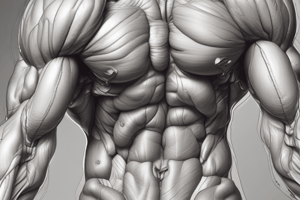Podcast
Questions and Answers
How do myofibrils contribute to the contraction of a sarcomere?
How do myofibrils contribute to the contraction of a sarcomere?
Myofibrils are long, cylindrical structures that contain sarcomeres, and their contraction occurs when the actin and myosin filaments slide past each other.
What role does ATP play in the contraction process of muscle fibers?
What role does ATP play in the contraction process of muscle fibers?
ATP provides the necessary energy for myosin heads to detach from actin, allowing the cycle of muscle contraction to continue.
Describe the function of myosin hooks during sarcomere contraction.
Describe the function of myosin hooks during sarcomere contraction.
Myosin hooks bind to specific actin binding sites, allowing myosin heads to pull the actin filaments during contraction.
How does titin contribute to the structural integrity of a sarcomere during contraction?
How does titin contribute to the structural integrity of a sarcomere during contraction?
What is the significance of actin binding sites in the context of muscle contraction?
What is the significance of actin binding sites in the context of muscle contraction?
Flashcards
Sarcomere
Sarcomere
The basic contractile unit of a muscle fiber, responsible for muscle contraction.
Myofibrils
Myofibrils
Long protein filaments within muscle fibers that contain sarcomeres, responsible for muscle contraction.
Myosin Hooks
Myosin Hooks
Projections from thick filaments (myosin) that bind to actin, pulling the thin filaments towards the center of the sarcomere.
Actin Binding Sites
Actin Binding Sites
Signup and view all the flashcards
Titin
Titin
Signup and view all the flashcards
Study Notes
Sarcomere Contraction Mechanism
-
Sarcomeres are the fundamental contractile units of muscle fibers. They are composed of overlapping protein filaments, primarily actin and myosin.
-
Myofibrils are cylindrical bundles of sarcomeres within muscle fibers. Their arrangement creates the striated appearance of muscle tissue.
-
The sliding filament theory describes how sarcomere shortening occurs. Myosin filaments "pull" on actin filaments, causing them to slide past each other.
Step-by-Step Contraction
-
Myosin Heads and ATP: Myosin heads, also known as myosin hooks, are crucial for this process. Myosin heads possess ATPase activity and use ATP hydrolysis to obtain energy. This energy allows the myosin heads to "cock" into a high-energy configuration.
-
Cross-Bridge Formation: The energized myosin heads bind to specific sites on actin filaments known as actin binding sites. This binding forms a cross-bridge between actin and myosin, which are like tiny molecular hooks.
-
Power Stroke: The release of the phosphate group from the ATP molecule initiates the power stroke. The myosin head pivots, pulling the actin filament toward the center of the sarcomere.
-
Detachment: A new ATP molecule binds to the myosin head, causing the detachment of the myosin head from the actin binding site. The cycle continues as long as ATP is available and the calcium ion concentration is high enough.
The Role of Calcium Ions
-
Calcium ions (Ca2+) play a crucial role in initiating muscle contraction. They are stored in the sarcoplasmic reticulum, a specialized network of membranes within muscle fibers.
-
When a nerve impulse stimulates the muscle fiber, calcium ions are released into the cytoplasm (sarcoplasm).
-
Calcium ions bind to a regulatory protein called troponin, causing a conformational change in the surrounding tropomyosin molecules.
-
This change exposes the actin binding sites, allowing myosin heads to bind and begin the contractile process.
Relaxation
-
Relaxation of a muscle occurs when the nerve impulse ceases.
-
Calcium ions are actively pumped back into the sarcoplasmic reticulum, reducing the calcium concentration in the cytoplasm.
-
Tropomyosin then covers the actin binding sites again, preventing further cross-bridge formation and muscle shortening.
Titin's Role
-
Titin is a giant protein that spans the length of the sarcomere.
-
Titin acts as a molecular spring, providing passive elasticity to the muscle fiber.
-
It helps return a muscle to its resting length after a contraction. It aids in the elastic recoil that aids in the muscle's return to its normal length.
-
It also stabilizes the position of the contractile filaments within the sarcomere and limits the range of sarcomere shortening.
Conclusion
-
The coordinated interaction of myosin heads and actin filaments, regulated by calcium ions, underpins the sliding filament theory of muscle contraction
-
ATP is the essential energy source for this process, driving the steps of cross-bridge cycling, detachment, and recocking/reattachment of the myosin heads. Essentially, one cycle of myosin heads binding, pulling, detaching, and recocking is a critical part of muscle contraction.
-
Titin plays a critical role in maintaining the structure and elasticity of the sarcomeres, enabling the smooth and coordinated function of muscle fibers.
Studying That Suits You
Use AI to generate personalized quizzes and flashcards to suit your learning preferences.




